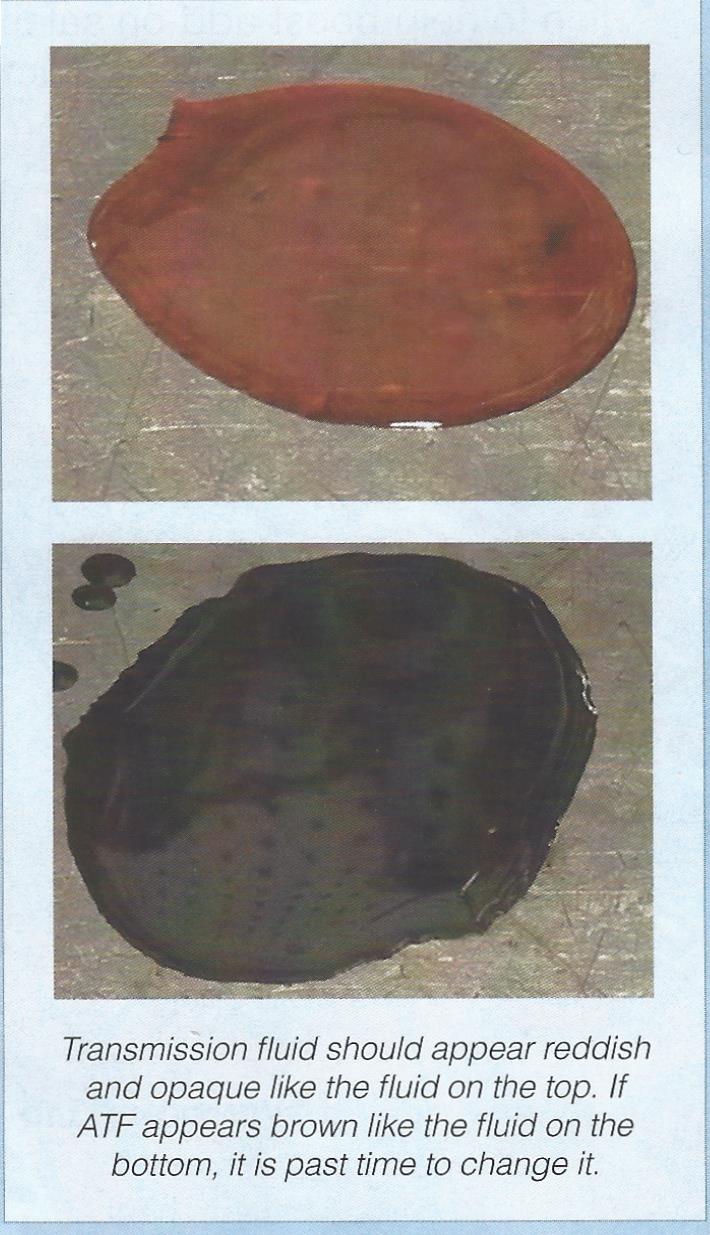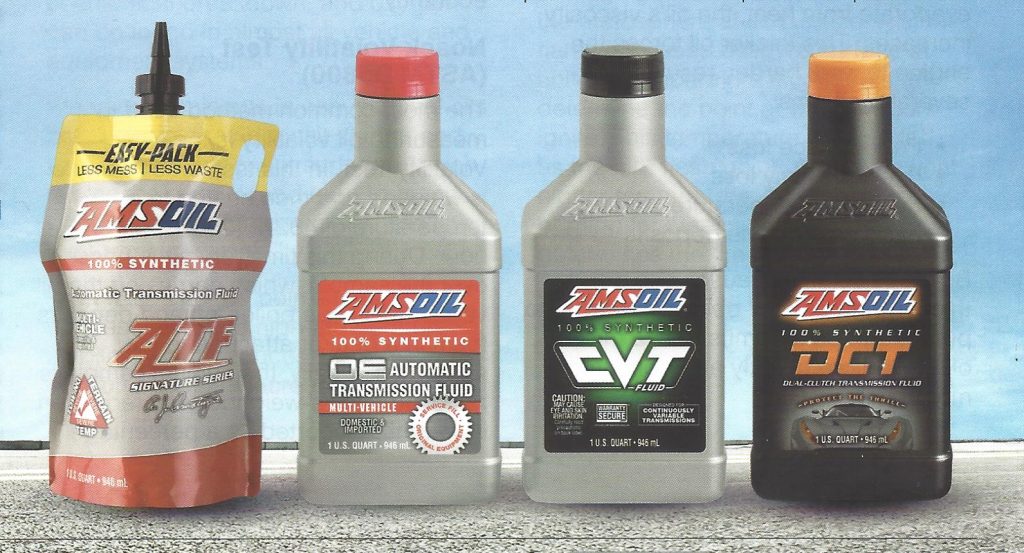Transmission fluid is a lubricant formulated to protect a vehicle’s gears and clutch packs while enabling smooth, crisp shifts. It plays a vital role in keeping vehicles working. Without it, transmission gears would rapidly wear out or overheat, resulting in a short life for the transmission and a big repair expense for the owner.

The basic work of a transmission sounds simple enough – transferring power from the engine to the wheels – but it might be the most complicated component on a car or truck. It houses a complex assortment of gears, clutches, solenoids and other components that select the proper gear for the operating conditions. For example, when you accelerate or pull a heavy load, the vehicle uses a lower gear that provides more torque. As you pick up speed on the highway, a higher gear is used to reduce engine rpm, increasing fuel efficiency.
Today’s transmissions are smaller and must manage higher horsepower and torque, all while delivering smoother shifts with longer fluid-life recommendations. These modern designs also pack in an enormous number of gears, clutch packs and narrow oil passageways that require a steady supply of high-quality fluid to function. Transmissions used for hauling or towing are subjected to massive torque and increased heat, the number-one enemy of any transmission.
But, transmission fluid is not always understood and tends to be overlooked and underappreciated by the average driver.
Types Of Transmissions
The two primary types of transmissions are manual and automatic. Other transmission designs include continuously variable transmissions (CVT) and dual-clutch transmissions (DCT). AMSOIL has products to maximize performance and protection for each of these transmission types, which we will cover a little later.
Properties Of Automatic Transmission Fluid
The main job of any lubricant is to create a fluid film between surfaces to prevent contact and reduce friction. In so doing, lubricants protect against wear and fight the damaging effects of extreme heat.
Transmission fluid not only lubricates and cools the moving parts of the transmission, a good fluid also excels at the following tasks:
- Functions As A Hydraulic Fluid
Automatic transmissions use pressurized transmission fluid to change gears. This stressor can cause the oil to shear and lose viscosity.
2. Delivers The Right Frictional Requirements
Engagement and disengagement of the clutch packs must happen flawlessly for optimum performance.
3. Protects Gears From Wear
Automatic transmissions contain a system of sun, planetary and ring gears that require a durable lubricant film to prevent metal-to-metal contact.
4. Fights Heat
Automatic transmissions generate more heat than manual transmissions. Heat accelerates oxidation, the chemical breakdown of the lubricant. Oxidation leads to sludge and varnish, which can clog narrow oil passages and contribute to clutch glazing. Without the right protection, vehicles can begin to shift hard, jerk or hesitate.
Properties Of Manual Transmission Fluid
Manual transmission fluid has fewer jobs to perform than automatic transmission fluid. Some manual transmissions work with or even require ATF. However, there are attributes where quality manual transmission fluids must excel, such as protecting soft metal (brass) synchronizers from corrosion.
Does Transmission Fluid Need To Be Changed?
Yes. Over time, transmission fluid oxidizes and becomes contaminated with particles and sludge. While transmission fluid doesn’t need to be changed as frequently as motor oil, it’s important to check it regularly.
If the transmission fluid level is low or the fluid has started to break down, the vehicle may shift poorly. Running low on fluid can damage transmission components and lead to catastrophic failure or expensive repairs.
How Often Should Transmission Fluid Be Changed?
The answer varies depending on the type of transmission and the mechanical stresses it must endure. It is often recommended to change transmission fluid every 30,000-150,000 miles (48,000-240,000 km). Sometimes it’s not recommended at all.
Original equipment manufacturer (OEM) recommendations for how often to change automatic transmission fluid cover a wide mileage range, depending on year, make and model. Plus, if your driving habits are like most motorists and fall under the “severe” designation (towing, hauling, daily short trips less than 10 miles [16km), etc.), many OEMs recommend changing transmission fluid more frequently.
These differences illustrate the importance of checking the recommendations in the owner’s manual. It will provide maintenance recommendations, typically in a table in the back. Many OEMs provide digital owner’s manuals online, so if you’ve lost yours, try a quick search.
In reality, many motorists completely forget about their transmission until it begins to shift hard, jerk or hesitate, especially if they have a filled-for-life transmission. However, so-called “filled-for-life” transmissions have a misleading name. And, not checking or changing transmission fluid is a reckless way to treat a transmission, especially if it’s used for towing or hauling.
The truth is, no lubricant will last forever and provide the protection the vehicle requires. Over time, lubricants deteriorate, especially if used under heavy loads, frequent starts and stops or daily short trips.
It’s a good idea to check a vehicle’s transmission fluid periodically to monitor fluid level and condition. However, this task has become more difficult in modern vehicles that often lack transmission dipsticks or have them in hard-to-reach locations under the vehicle.
Fluid should be checked immediately if performance begins to suffer.
Choosing The Right Transmission Fluid
Finding out what kind of transmission fluid is needed can be a challenge. It’s best to start with your owner’s manual or use the AMSOIL Product Guide to find the right transmission fluid. AMSOIL Signature Series Synthetic Automatic Transmission Fluid and OE Synthetic Automatic Transmission Fluid are both recommended for most of the common ATF specs on the market.
Signature Series Synthetic Automatic Transmission Fluid
Signature Series ATF (ATF, ATL) is our premium transmission fluid. It’s designed for hard-working vehicles that operate in severe service. It handles heat so well, you can confidently double your vehicle manufacturer’s severe-service drain interval with guaranteed AMSOIL protection. It withstands the rigors of heavy towing, elevated temperatures and challenging terrain, and remains fluid in sub-zero temperatures. Signature Series ATF provides reserve protection for vehicles that endure heavy use and abuse.
OE Synthetic Automatic Transmission Fluid
OE ATF (OTF, OTL) provides passenger-car/light-truck transmissions excellent wear protection, sludge resistance and extreme-temperature performance throughout original equipment manufacturer (OEM) recommended drain intervals. It provides excellent cold-weather performance, guards against leaks and promotes smooth, shudder-free shifts. OE Synthetic ATF is perfect for your daily commuter.
“CVT” stands for continuously variable transmission. A CVT transmission uses a pair of variable-diameter pulleys and a belt or chain to provide unlimited gear ratios, enabling the vehicle to smoothly adjust to the optimal gear ratio in real time. CVTs require a unique transmission fluid with specialized frictional characteristics designed to ensure the belt or chain remains in contact with the pulleys without slipping. AMSOIL Synthetic CVT Fluid (CVT) provides outstanding metal-to-metal frictional properties and excellent protection and performance for CVTs throughout vehicle manufacturer-recommended drain intervals. In elevated heat, Synthetic CVT Fluid’s thermally stable formulation guards against the harmful effects of thermal breakdown. It resists the formation of varnish that can threaten transmission performance and life.
AMSOIL 100 Synthetic DCT Fluid
Dual-clutch transmissions (DCTs) are automatic transmissions based on the architecture of manual transmissions.
The complex system essentially consists of two manual transmissions in the same housing. As one clutch is engaged, the other readies the next appropriate gear, minimizing the interruption of power and improving performance and efficiency.
A specially formulated fluid is required to maintain the high-performance output of these advanced transmissions. AMSOIL 100% Synthetic DCT Fluid (DCT) is designed to protect high-tech dual-clutch transmissions during the most intense, high-heat operating conditions.
It provides the fast, smooth shifts drivers expect. AMSOIL Synthetic DCT Fluid resists the extreme heat in today’s high-temperature DCTs to provide complete protection for gears, bearings and other vital parts. Its high film strength and anti-wear/extreme-pressure additives are specifically designed to protect the metal surfaces of DCTs.
Transmission fluid is a vital part of vehicle performance. Although maintenance is easy to overlook, you need to make it a part of their maintenance routine to avoid reduced performance and expensive repair bills.
Which AMSOIL Synthetic Fluid Do I Need?
You can look up the appropriate AMSOIL Synthetic Fluids for your vehicle by using the Product Lookup Guides. To use the lookups you will need the Year, Make, Model and Engine in your vehicle. If you are looking up Transmission or Differential fluid requirements you may need the transmission or differential numbers if there were more than one version used in your vehicle.
SLS Note: Don’t wait until you notice a problem with your transmission to install AMSOIL Transmission Fluid. While AMSOIL has proven it can significantly reduce wear over time, it can’t repair damage that is already done. Change your fluid before the damage is done. Check out the AMSOIL Limited Warranty. Then try and find your manufacturer’s fluid warranty.
AMSOIL Limited Warranty – Lubricants

Reproduced With The Permission Of AMSOIL INC. All Rights Reserved.
For more information or pricing on the quality line of AMSOIL Products contact SLS Associates. Whether you are a Consumer, Retailer, or Commercial Business, we will answer your questions, explain any options and you take it from there. If you choose to try AMSOIL products we will give you our best price and you make the decision. No pressure. It’s your choice.
Click Here if you would like to browse the current AMSOIL Catalog
